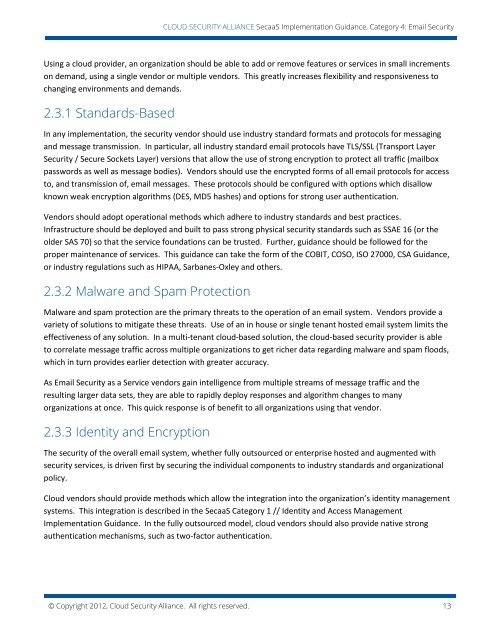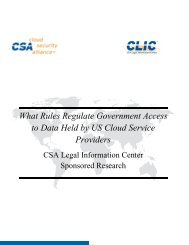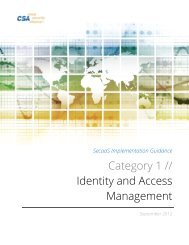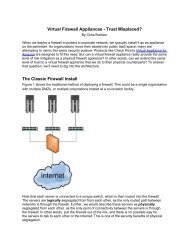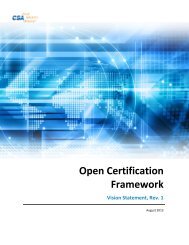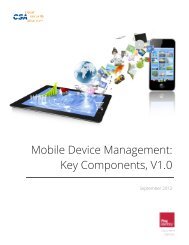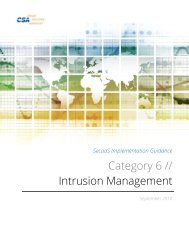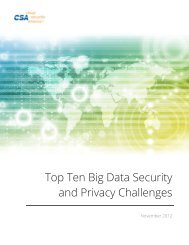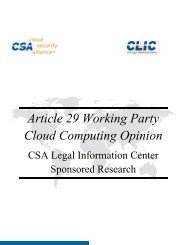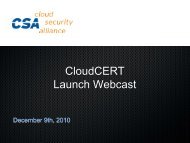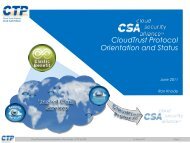Email Security Implementation Guidance - Cloud Security Alliance
Email Security Implementation Guidance - Cloud Security Alliance
Email Security Implementation Guidance - Cloud Security Alliance
- No tags were found...
Create successful ePaper yourself
Turn your PDF publications into a flip-book with our unique Google optimized e-Paper software.
CLOUD SECURITY ALLIANCE SecaaS <strong>Implementation</strong> <strong>Guidance</strong>, Category 4: <strong>Email</strong> <strong>Security</strong>Using a cloud provider, an organization should be able to add or remove features or services in small incrementson demand, using a single vendor or multiple vendors. This greatly increases flexibility and responsiveness tochanging environments and demands.2.3.1 Standards-BasedIn any implementation, the security vendor should use industry standard formats and protocols for messagingand message transmission. In particular, all industry standard email protocols have TLS/SSL (Transport Layer<strong>Security</strong> / Secure Sockets Layer) versions that allow the use of strong encryption to protect all traffic (mailboxpasswords as well as message bodies). Vendors should use the encrypted forms of all email protocols for accessto, and transmission of, email messages. These protocols should be configured with options which disallowknown weak encryption algorithms (DES, MD5 hashes) and options for strong user authentication.Vendors should adopt operational methods which adhere to industry standards and best practices.Infrastructure should be deployed and built to pass strong physical security standards such as SSAE 16 (or theolder SAS 70) so that the service foundations can be trusted. Further, guidance should be followed for theproper maintenance of services. This guidance can take the form of the COBIT, COSO, ISO 27000, CSA <strong>Guidance</strong>,or industry regulations such as HIPAA, Sarbanes-Oxley and others.2.3.2 Malware and Spam ProtectionMalware and spam protection are the primary threats to the operation of an email system. Vendors provide avariety of solutions to mitigate these threats. Use of an in house or single tenant hosted email system limits theeffectiveness of any solution. In a multi-tenant cloud-based solution, the cloud-based security provider is ableto correlate message traffic across multiple organizations to get richer data regarding malware and spam floods,which in turn provides earlier detection with greater accuracy.As <strong>Email</strong> <strong>Security</strong> as a Service vendors gain intelligence from multiple streams of message traffic and theresulting larger data sets, they are able to rapidly deploy responses and algorithm changes to manyorganizations at once. This quick response is of benefit to all organizations using that vendor.2.3.3 Identity and EncryptionThe security of the overall email system, whether fully outsourced or enterprise hosted and augmented withsecurity services, is driven first by securing the individual components to industry standards and organizationalpolicy.<strong>Cloud</strong> vendors should provide methods which allow the integration into the organization’s identity managementsystems. This integration is described in the SecaaS Category 1 // Identity and Access Management<strong>Implementation</strong> <strong>Guidance</strong>. In the fully outsourced model, cloud vendors should also provide native strongauthentication mechanisms, such as two-factor authentication.© Copyright 2012, <strong>Cloud</strong> <strong>Security</strong> <strong>Alliance</strong>. All rights reserved. 13


